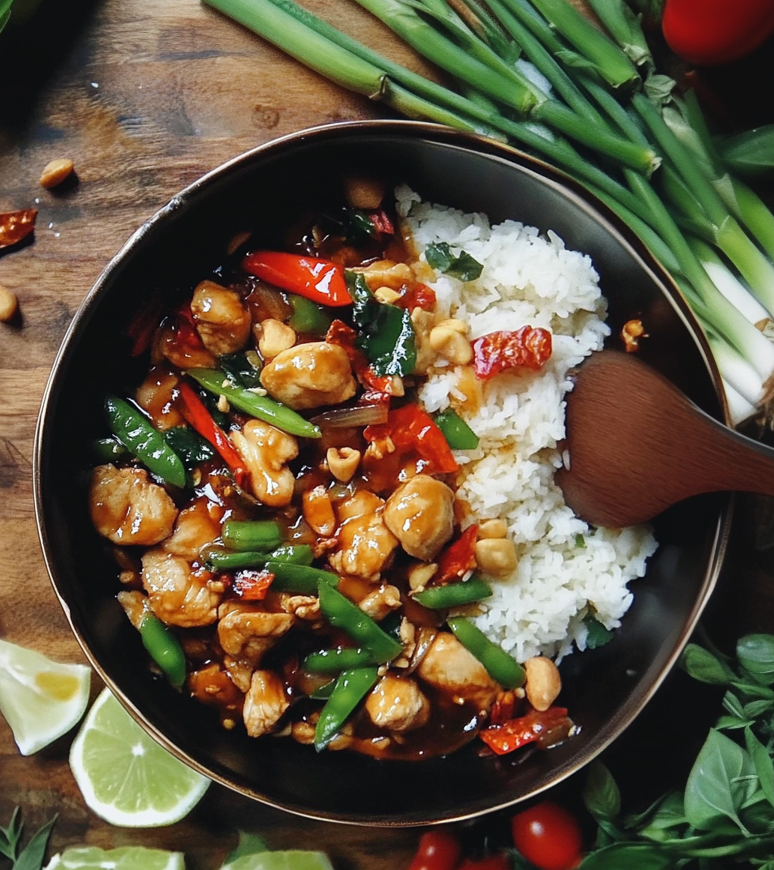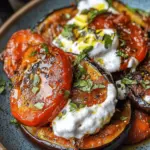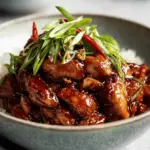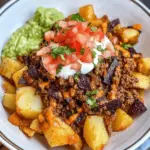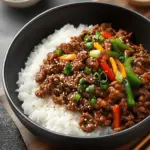Kung Pao Chicken is a classic Sichuan dish that masterfully balances savory, sweet, tangy, and spicy flavors. This stir-fry features tender chicken pieces, crunchy peanuts, vibrant bell peppers, and aromatic spices, all brought together in a rich, flavorful sauce. Quick to prepare and bursting with taste, it’s a perfect choice for a satisfying dinner that rivals your favorite takeout.
Full Recipe:
Ingredients
Chicken:
- 1.5 lbs boneless, skinless chicken thighs or breasts, cut into 1-inch cubes
- 1 tablespoon cooking oil
- 2 tablespoons cooking sherry
- 2 tablespoons soy sauce
- 2 tablespoons cornstarch
Sauce:
- ½ cup chicken stock
- 4 tablespoons soy sauce
- 2 tablespoons white vinegar
- 2 tablespoons cooking sherry
- 2 tablespoons hoisin sauce
- 2 tablespoons sugar
- 1 tablespoon cornstarch
Stir-Fry:
- 4 tablespoons cooking oil, divided
- 2.5 tablespoons garlic (6–8 cloves), minced
- 3 tablespoons ginger, minced
- 1 red bell pepper, chopped
- 1 green bell pepper, chopped
- 8–10 dried chilies
- 4 green onions, cut into 1-inch pieces
- ½ cup roasted peanuts
- 2 teaspoons sesame oil
Directions
- Marinate the Chicken: In a bowl, combine the chicken cubes with cooking oil, cooking sherry, soy sauce, and cornstarch. Mix well and let it marinate for at least 15 minutes.
- Prepare the Sauce: In a separate bowl, whisk together chicken stock, soy sauce, white vinegar, cooking sherry, hoisin sauce, sugar, and cornstarch until smooth. Set aside.
- Stir-Fry the Chicken: Heat 2 tablespoons of cooking oil in a wok or large skillet over medium-high heat. Add the marinated chicken and stir-fry for 3–5 minutes until browned and cooked through. Remove the chicken from the wok and set aside.
- Cook the Aromatics and Vegetables: In the same wok, add the remaining 2 tablespoons of cooking oil. Add minced garlic, ginger, dried chilies, and chopped bell peppers. Stir-fry for 2–3 minutes until fragrant and the peppers are slightly tender.
- Combine and Finish: Return the cooked chicken to the wok. Add the prepared sauce and stir well to coat all ingredients. Cook for an additional 2–3 minutes until the sauce thickens. Add green onions, roasted peanuts, and sesame oil. Stir to combine and heat through.
- Serve: Transfer the Kung Pao Chicken to a serving dish and enjoy hot, preferably over steamed rice.
Nutrients
Per serving (based on 6 servings):
- Calories: Approximately 450 kcal
- Protein: 30g
- Carbohydrates: 20g
- Fat: 25g
- Fiber: 3g
- Sugar: 8g
Historical and Cultural Significance
The origins of Kung Pao Chicken date back to the Qing Dynasty, named after Ding Baozhen, a governor of Sichuan province whose title was “Gongbao,” which translates to “Palace Guardian.” This dish was reportedly a favorite of his, and its name pays homage to this historical figure. Traditionally, Sichuan cuisine is famous for its bold use of Sichuan peppercorns, which provide a unique numbing sensation known as “mala,” a combination of spicy heat and numbing tongue sensation.
Kung Pao Chicken exemplifies these characteristics with the use of dried chilies and sometimes Sichuan peppercorns, making it a perfect representation of the region’s culinary style. Its balance of flavors also reflects the Chinese culinary philosophy of harmony—combining sweet, sour, spicy, and savory into a dish that is more than the sum of its parts.
Flavor Profile and Ingredients
Kung Pao Chicken’s signature taste is achieved through a careful balance of ingredients and cooking techniques. The sauce combines soy sauce, hoisin sauce, vinegar, and sugar, which creates a complex base that is sweet, salty, and tangy. The heat from dried red chilies and sometimes fresh chilies delivers a spicy kick, while roasted peanuts add a rich, nutty crunch and a contrasting texture to the tender chicken pieces.
Aromatic garlic and ginger are essential, providing depth and warmth, and the occasional use of sesame oil adds a fragrant finish. Bell peppers and green onions are common vegetable additions, offering freshness and a slight sweetness that counterbalances the heat.
The dish relies heavily on the technique of stir-frying, which is fast and done at high heat. This method helps retain the vibrant colors of the vegetables and ensures the chicken remains juicy and tender while allowing the flavors to meld quickly.
Nutritional Benefits
Kung Pao Chicken is not only flavorful but also nutritious. The primary protein source, chicken, is lean and high in essential amino acids, important for muscle repair and overall body function. The peanuts provide healthy fats, protein, and fiber, which contribute to heart health and satiety.
Vegetables like bell peppers add antioxidants, vitamins A and C, and dietary fiber, supporting immune health and digestion. The use of garlic and ginger has long been valued in traditional medicine for their anti-inflammatory and immune-boosting properties.
However, it’s worth noting that due to the sauces used, Kung Pao Chicken can be higher in sodium and sugar. Adjusting these components by reducing soy sauce or sugar can make the dish even healthier while retaining most of its iconic flavor.
Adaptations and Variations
Kung Pao Chicken has evolved beyond its traditional Sichuan roots into many regional and international variations. Some versions increase or decrease the spice level depending on local palates, while others substitute peanuts with cashews or almonds for a different nutty flavor.
Vegetarian versions often replace chicken with tofu, tempeh, or seitan, maintaining the sauce and vegetable components. This flexibility makes Kung Pao Chicken a versatile dish that can suit various dietary preferences.
In American Chinese cuisine, Kung Pao Chicken is sometimes sweeter and less spicy than the authentic Sichuan version. The addition of bell peppers and green onions is common, providing color and freshness, and the dish is typically served with steamed rice to balance its robust flavors.
Cooking Techniques and Tips
Mastering Kung Pao Chicken requires attention to timing and heat control. The stir-fry process should be fast and hot to achieve the signature sear on the chicken and to keep the vegetables crisp.
Marinating the chicken with soy sauce, cornstarch, and cooking wine helps tenderize the meat and create a glossy finish. The sauce, often thickened with cornstarch, coats the ingredients evenly, binding the flavors together.
Toast the dried chilies briefly to release their aroma without burning them, as burnt chilies can impart bitterness. The peanuts are usually roasted separately to maintain their crunch.
Using a wok is ideal for this dish, as its shape allows for quick tossing and even heat distribution. However, a large skillet can also work well.
Pairing and Serving Suggestions
Kung Pao Chicken is traditionally served hot, accompanied by steamed jasmine rice or fried rice, which helps mellow the dish’s bold flavors. The rice acts as a neutral base, absorbing the sauce and providing balance.
For a well-rounded meal, it can be paired with simple sides such as steamed or stir-fried vegetables like bok choy, broccoli, or snow peas. A light soup, such as egg drop or hot and sour soup, complements the richness of the dish.
For those who enjoy beverages, a chilled jasmine tea or a light lager pairs beautifully, helping to cleanse the palate between spicy bites.
Health Considerations
While Kung Pao Chicken is a wholesome dish with many nutritional benefits, moderation is key due to the sugar and sodium content in the sauces. Using low-sodium soy sauce and reducing added sugar can make the dish healthier.
For those monitoring calorie intake, opting for chicken breast over thighs lowers fat content. Increasing vegetable portions boosts fiber and micronutrient intake, making the dish even more nutrient-dense.
Homemade versions offer full control over ingredients, avoiding preservatives and additives common in restaurant or pre-packaged sauces.
The Global Popularity of Kung Pao Chicken
Kung Pao Chicken has transcended its regional roots to become an international favorite, illustrating the global influence of Chinese cuisine. Its bold flavors and satisfying texture make it appealing to diverse palates, and its adaptability means it can be found in countless variations worldwide.
It’s a common dish featured in Chinese takeout menus across the globe and inspires countless home cooks to try their hand at recreating its authentic taste. Cooking Kung Pao Chicken at home not only brings a taste of Sichuan culture into your kitchen but also allows you to customize the dish to suit your flavor preferences and dietary needs.
Conclusion
Kung Pao Chicken stands as a perfect example of Chinese culinary artistry—a harmonious balance of taste, texture, and aroma wrapped in a vibrant, satisfying dish. Its historical roots, nutritional benefits, and flavor complexity make it a cherished recipe worldwide.

